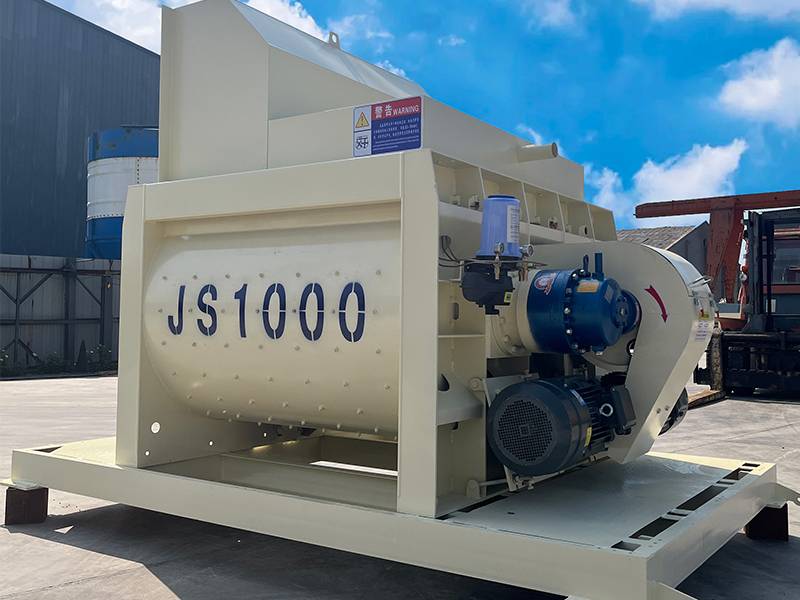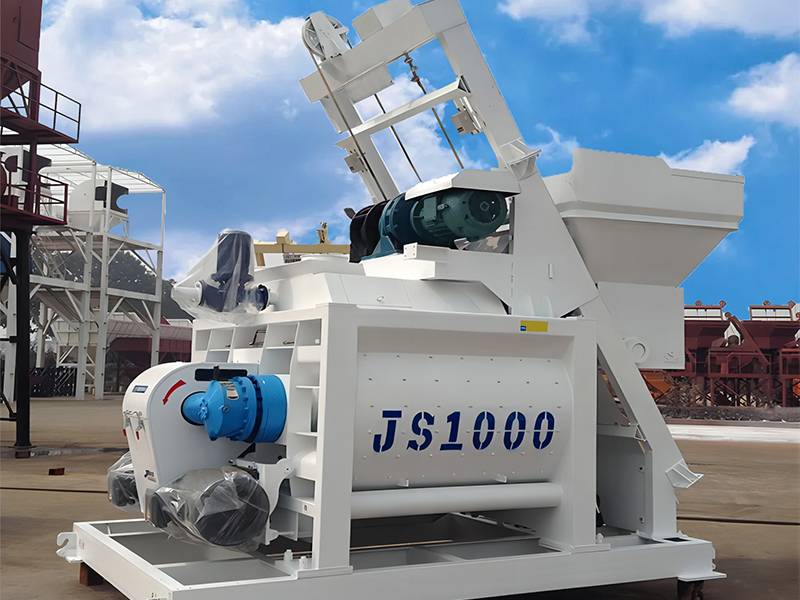How Much Do You Know About JS1000 Double Shaft Concrete Mixer?
The JS1000 concrete mixer, also known as a 1 cubic meter concrete mixer, primarily belongs to the series of twin-shaft forced concrete mixers. This concrete mixers are mainly used for mixing building materials such as cement, sand and gravel, and various types of dry-mixed mortar. Regarding its types, although there may be different brands, configurations, or customized products tailored for specific application scenarios in the market, from the perspective of basic structure and function, the JS1000 concrete mixer can be mainly classified as a twin-shaft mixer with forced mixing capabilities. Below is a detailed explanation of its types:
I. Basic Type
Twin-shaft forced concrete mixer: This is the main type of JS1000 concrete mixer, featuring high automation, excellent mixing quality, high efficiency, low energy consumption, low noise, easy operation, and fast discharging speed. Its mixing system typically consists of a directly connected planetary cycloidal reducer, open gears, mixing tank, mixing device, oil supply device, etc.
II. Differences in Configuration and Function
Despite having the same basic type, JS1000 concrete mixers may have some differences in configuration and function to meet the needs of different customers. For example:
Loading Methods: Some JS1000 concrete mixers adopt an automatic loading system, which can significantly improve production efficiency; while others use manual or semi-automatic loading methods.
Water Supply System: Advanced JS1000 concrete mixers may be equipped with precise water supply systems to ensure the optimal water-cement ratio of the concrete.
Electrical System: The configuration of the electrical system may also vary depending on the manufacturer and customer requirements, including the level of intelligence of the control system, motor power, and energy efficiency.
Regarding loading methods, there are mainly two types for JS1000 concrete mixers: hopper lift loading and belt loading.
Hopper Lift Loading: This method is typically used in HZS50 concrete mixing stations. The hopper raises materials to the feed inlet of the mixer through a lifting mechanism and then pours them into the mixer for mixing. This method is relatively simple, low in cost, and suitable for customers with limited space or budget.
Belt Loading: This method is commonly used in HZS60 concrete mixing stations. The belt conveyor continuously and stably transports materials to the feed inlet of the mixer, improving production efficiency. Additionally, the belt loading method reduces material loss and contamination during transportation, ensuring the cleanliness of the mixer and the working environment. However, the cost of the belt loading method is relatively higher and requires a certain amount of space.


When selecting a loading method, customers should comprehensively consider their actual needs and budget. If space is limited or the budget is tight, the hopper lift loading method can be chosen; if higher production efficiency and a better working environment are pursued, then the belt loading method can be selected.
III. Customized Products
Furthermore, some manufacturers can provide customized JS1000 concrete mixers according to the specific needs of customers. These customized products may differ from standard products in size, shape, color, material, function, etc., to meet the customer's specific application scenarios and process requirements.
IV. Brand and Price Differences
In the market, there are also certain differences in the brands and prices of JS1000 concrete mixers. Mixers of different brands may vary in quality, performance, and after-sales service, while prices are influenced by factors such as production costs, market competition, and customer demands. Therefore, when selecting a JS1000 concrete mixer, customers need to comprehensively consider aspects such as brand, price, performance, and after-sales service.
V. Performance Characteristics
1. High Mixing Efficiency: The JS1000 mixer adopts a twin-shaft mixing host, with intense mixing, short mixing time, and high work efficiency. Its mixing arms and blades form a spatially intermittent spiral belt structure, capable of producing three-dimensional mixing effects along both radial and axial directions, exerting comprehensive effects such as pushing, rubbing, and squeezing on the materials to ensure that the materials achieve a high homogeneity mixing effect within a short period.
2. Reasonable Structure: The mixer is designed reasonably with a compact overall structure and a small footprint. At the same time, the tight cooperation between its components results in low energy loss and low energy consumption during the mixing process.
3. Low Noise: The JS1000 mixer adopts imported rubber seals combined with alloy parts, as well as unique protective hoops and airway designs, effectively reducing noise during the mixing process and improving the working environment.
4. Easy Operation: The mixer has a high degree of automation and is easy to operate. Its control system is stable and reliable, with functions such as weight compensation, deduction, continuous production, and intelligent alarms, enabling operators to easily monitor the operating status of the mixer and make timely adjustments.
5. Easy Maintenance: The components of the JS1000 mixer are designed reasonably, making them easy to dismantle and replace. Additionally, its wear-resistant alloy mixing arms and hydraulically driven discharging gates extend the service life of the mixer and reduce maintenance costs.
6. Environmentally Friendly and Non-polluting: The mixer adopts fully enclosed loading and negative pressure pulse back-blowing dust collection devices, effectively preventing dust pollution and meeting environmental requirements.
7. Wide Application Range: The JS1000 mixer can be used alone or combined into 50 or 60 types of concrete mixing stations. It is suitable for mixing dry-hard, plastic, fluid, and light aggregate concretes as well as various mortars, and is widely used in large and medium-sized prefabricated component factories and industrial and civil construction projects such as roads, bridges, water conservancy, and docks.
In summary, the JS1000 concrete mixer can be mainly classified as a twin-shaft mixer with forced mixing capabilities. When purchasing, customers should select suitable products based on their actual needs and budget.











